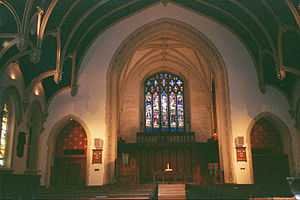Chancel


In church architecture, the chancel (or presbytery) is the space around the altar in the sanctuary at the liturgical east end of a traditional Christian church building, possibly including the choir.[1] It may terminate in an apse.
Following the exposition of the doctrine of transubstantiation at the fourth Lateran Council of 1215, clergy were required to ensure that the blessed sacrament was to be kept protected from irreverent access or abuse; and accordingly the area of the church used by the lay congregation was to be screened off from that used by the clergy. This distinction was enforced by the development of canon law, by which the construction and upkeep of the chancel was the responsibility of the rector, whereas the construction and upkeep of the nave was the responsibility of the parish.
As well as the altar, the chancel usually houses the credence table and seats for officiating and assisting ministers. In Anglican and Methodist churches it will usually include the choir. In some traditions, the pulpit and lectern may be in the chancel, but in others these functions are considered proper to the nave.

The chancel is typically raised somewhat above the level of the nave, where the congregation gathers. It may be separated from the nave by a rood screen, a rail, a sanctuary bar, or an open space. In some churches, the congregation may gather on three sides or in a semicircle around the chancel.
The word "chancel" derives from the French usage of chancel from the Late Latin word cancellus ("lattice").[1][2] This refers to the typical form of rood screens. The chancel was formerly known as the presbytery, because it was reserved for the clergy.[3]
A chancel arch is an arch which separates the chancel (sanctuary or choir) from the nave of a church.[4]
See also
References
- Notes
- ↑ 1.0 1.1 Curl, James Stevens (2006). A Dictionary of Architecture and Landscape Architecture. Oxford University Press. p. 166. ISBN 0198606788.
- ↑ Harper, Douglas (2001). "Chancel". Online Etymology Dictionary. Retrieved 2013-10-29.
- ↑
 "Presbytery". Catholic Encyclopedia. New York: Robert Appleton Company. 1913.
"Presbytery". Catholic Encyclopedia. New York: Robert Appleton Company. 1913. - ↑ Harris, Cyril M. (1977). Illustrated Dictionary of Historic Architecture. Courier Dover Publications. p. 105. ISBN 0486132110.